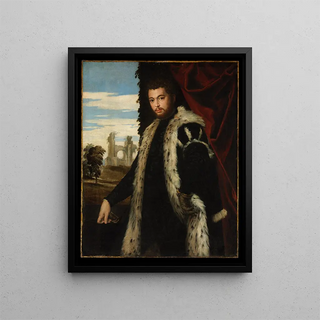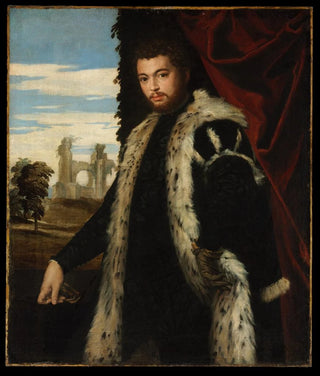Art print | Portrait of a man - Paolo Véronèse


View from behind

Frame (optional)
Portrait of a Man - Paolo Véronèse – Captivating Introduction
The "Portrait of a Man" by Paolo Véronèse is a work that transcends the simple frame of painting to become a true window into the human soul. This painting, created by one of the masters of the Italian Renaissance, evokes psychological depth and chromatic richness that captivate the viewer. Through the intense and mysterious gaze of its subject, Véronèse invites us to explore not only the identity of the depicted man but also the universal themes of beauty, power, and the human condition. The art print of this masterpiece allows you to delve into the fascinating world of Venetian art, while offering a unique opportunity to appreciate the artistic heritage of this iconic artist.
Style and uniqueness of the work
Véronèse's style is characterized by a bold use of color and light, which gives his portraits an unparalleled vibrancy. In the "Portrait of a Man," the rich and nuanced palette demonstrates his skill in playing with contrasts, highlighting the textures of clothing, and creating an intimate atmosphere. The subject, dressed in sumptuous attire, is depicted with fine details that reflect meticulous observation. The interplay of shadow and light, along with the elegant posture of the figure, adds a dynamic dimension to the work, making it almost alive. Véronèse succeeds in capturing not only the physical appearance of his model but also a deeper essence—a kind of silent dialogue between the viewer and the portrait.
The artist and his influence
Paolo Véronèse, whose real name is Paolo Caliari, was born in Verona in 1528 and established himself in Venice, where he left an indelible mark on art history. His innovative approach to composition and his ability to incorporate narrative elements into his portraits influenced many artists of his time and subsequent generations. Véronèse was not only a master of religious painting and historical scenes but also knew how to capture the spirit of portraiture, blending realism and idealization. His work helped redefine portraiture during the Renaissance, emphasizing the

Matte finish

View from behind

Frame (optional)
Portrait of a Man - Paolo Véronèse – Captivating Introduction
The "Portrait of a Man" by Paolo Véronèse is a work that transcends the simple frame of painting to become a true window into the human soul. This painting, created by one of the masters of the Italian Renaissance, evokes psychological depth and chromatic richness that captivate the viewer. Through the intense and mysterious gaze of its subject, Véronèse invites us to explore not only the identity of the depicted man but also the universal themes of beauty, power, and the human condition. The art print of this masterpiece allows you to delve into the fascinating world of Venetian art, while offering a unique opportunity to appreciate the artistic heritage of this iconic artist.
Style and uniqueness of the work
Véronèse's style is characterized by a bold use of color and light, which gives his portraits an unparalleled vibrancy. In the "Portrait of a Man," the rich and nuanced palette demonstrates his skill in playing with contrasts, highlighting the textures of clothing, and creating an intimate atmosphere. The subject, dressed in sumptuous attire, is depicted with fine details that reflect meticulous observation. The interplay of shadow and light, along with the elegant posture of the figure, adds a dynamic dimension to the work, making it almost alive. Véronèse succeeds in capturing not only the physical appearance of his model but also a deeper essence—a kind of silent dialogue between the viewer and the portrait.
The artist and his influence
Paolo Véronèse, whose real name is Paolo Caliari, was born in Verona in 1528 and established himself in Venice, where he left an indelible mark on art history. His innovative approach to composition and his ability to incorporate narrative elements into his portraits influenced many artists of his time and subsequent generations. Véronèse was not only a master of religious painting and historical scenes but also knew how to capture the spirit of portraiture, blending realism and idealization. His work helped redefine portraiture during the Renaissance, emphasizing the






